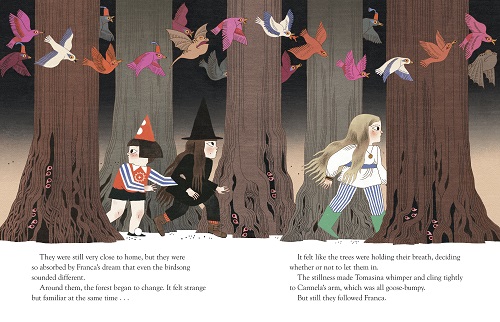The Queen in the Cave: “The wonders were infinite.”
 June 9th, 2022 by jules
June 9th, 2022 by jules
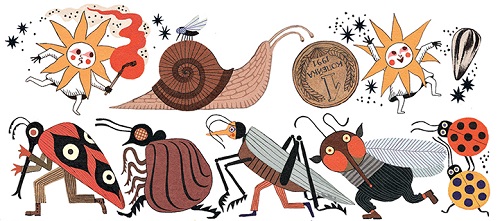
The U.S. edition of Júlia Sardà’s The Queen in the Cave (Candlewick) was released last month (it was first published in the UK last year), but I read it months before that. (I ended up with an early review copy.) And it’s been on my mind all that time. This, what the publisher calls a modern fairy tale, is Sardà’s debut as both author and illustrator. And it’s mesmerizing.
This is the story of a girl’s mysterious call to the forest. The girl, Franca, has dreamt of “a marvelous queen who lives in the darkest cave.” Franca decides to seek this queen and convinces her two sisters to join her. On their way there, they take in fantastical sights — Grandmother Spider, with whom they have tea; the Maze of Ants; Big Mama’s funeral party (Big Mama is a rat); Hanging Bats; their “crabby old neighbor, and her wicked friends”; and so much more — and have strange adventures.
And the queen that Franca was called to meet at the end of their journey? She is no less than an undomesticated version of herself.
Because it’s the kind of book best experienced on your own terms, I am going to list — at the risk of being excessively gimmicky (given that you’re reading Seven Impossible Things Before Breakfast) — my seven favorite things about it and hope that what you see here prompts you to go find a copy of your own:
- Before we even get to the title page, we read that, not only does it all start with Franca’s “funny feeling” (this urge to see the queen), but we also see that a disembodied hand, poking out of a magical fuchsia-colored cloud, is tapping her on the back of her head. This is delightfully creepy. I mean, haven’t we all had this precise feeling before? No? Just me? I doubt it.
- Franca attempts to describe her “strange” feeling by saying, in part, that it is like “when you have static electricity in your hair, and no matter how much you try to brush it, it slowly sticks to your face and to your hands.” Can Sardà write more books? Please. I hope she does.
- When Franca makes it outside, “the smell of the wet soil made her want to kick off her shoes and run into the unknown.” THE SMELL OF THE WET SOIL! This is a kid ready to tap into her truly unrestrained side. How many children’s books encourage that? And I mean really encourage it? And this, by the way, is an adventure Franca regards with great seriousness, telling her sisters (after shushing them): “We’re going deep down into the unknown.”
- Sardà’s utterly spectacular tableaux in this book and the way she composes a spread amount to nothing short of beguiling. I have some spreads here so that you can see for yourself, but there is so much more not pictured here. This includes spreads with tiny, telling details (both at their home — before their journey, that is — and beyond); the nearly delirious, ferocious grin on Franca’s face in early spreads; the dense, verdant woods they travel; and the host of bizarre, wondrous creatures they see on their way. Plus more.
- The moment Franca meets “not Franca” gives me goosebumps. So does reading how she feels at that moment: “She felt complete.” Ah. She has met her uninhibited self (not pictured below), and she is now whole.
- Best of all (and the reason I can’t get this book out of my mind): Franca stays to be with the queen where “time doesn’t exist.” Franca’s sisters, who are scared, head back through the forest in a rather shocked state; they each want to be home. Says Tomasina, the youngest, “There’s lasagna for dinner. And cake for dessert.” Later, when Franca slides through their bedroom window at night, covered in mud, she is still in her feral state — or at least looks like it. (Do we really know for sure it’s Franca and not the queen? Is that a valid question we can ask at this point? That’s debatable, I suppose.) This is remarkably noteworthy. She opted for the wild rumpus and returned home, but she is now changed. She scratched the itch: “I don’t think I feel that strange feeling anymore,” she tells Carmela. But she’s not the Franca who left. She’s the Franca she met there. And that Sardà gave her the adventure to begin with is my favorite thing about this curious tale. She could have easily had Franca declare her love for her cozy home or even given her a small, anemic adventure before then declaring it. Instead, Franca gives in, one hundred and ten percent, to the earthy, sensual, boisterous, wolfish side of herself.
- The book’s dedication is, in part, to “the endless summers with my cousins, before the strangeness began.” Much can be read into this. It is gloriously open-ended. Do with it as you’d like.
(Click spread to enlarge and read text in its entirety)
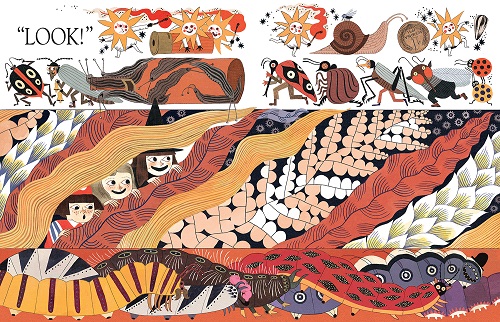
(Click spread to enlarge)
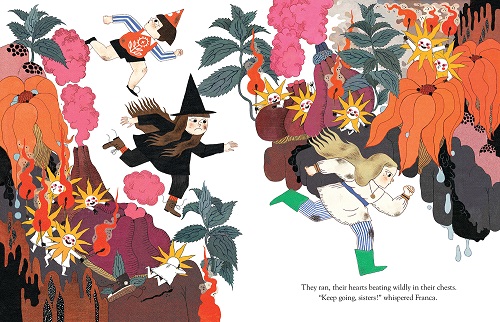
(Click spread to enlarge and read text in its entirety)
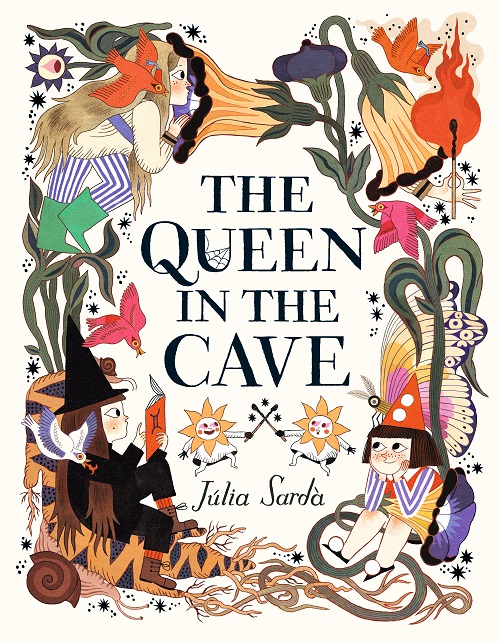
THE QUEEN IN THE CAVE. Copyright © 2021 by Júlia Sardà. First published by Walker Books Ltd. (UK) 2021. First U.S. edition 2022. Illustrations reproduced by permission of the publisher, Candlewick Studio, an imprint of Candlewick Press, Somerville, Massachusetts.
